
| Preface | Perth | Stuart Highway | Uluru | Port Douglas | Sydney | Sturt Highway | Kangaroo Island | Indian Pacific | Perth |
Road Trip: Sydney to Adelaide
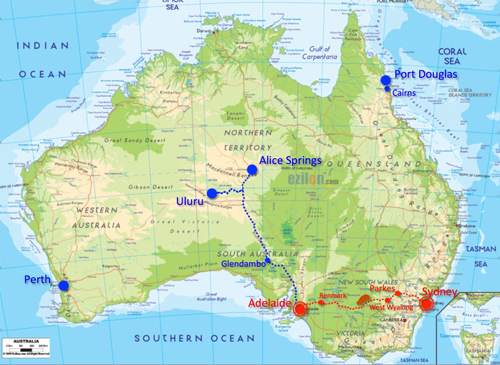
We had arrived in Sydney at rush hour, so by the time the exit ramp had dumped us onto the 8-lane highway leading to Sydney and the north harbor, and I had two seconds to glance at the instrument panel, it was waaay too late to complain about the Oil Warning light which not only warned of the dire consequences of not getting it checked out immediately, but even more annoyingly, obliterated other fairly useful instruments such as the speedometer and gas gauge. It was dark, the 8 lanes were bumper to bumper and we both knew that even if we had the patience and stamina and could turn around immediately, it would take at least an hour and more likely closer to two before were were back at this point. Especially as the next exit was several miles, not right here, and the traffic was just as bad in the other direction. So much for our fancy free upgrade from the vanilla Camray we had ordered to a Holden 6-cylinder full size sedan. The rental lady had made it sound pretty special but it said Buick to me, and our relationship was not improving. Claudia managed to get a real person on the phone, and between them they figured out a way to make our preferred solution work: find a rental place in north west Sydney that we could visit first thing on Saturday morning as we started to make our way west.
So here we are, Saturday morning. The plan was to get on the road early enough to be at the Avis rental when it opened. For reasons I no longer recall, but probably related to the whole Holden POS incident, and our not being able to leave town until we got it fixed, we were both a little short of patience this morning. As a direct result of which we made a tactical error that we did not discover until we got home several weeks later: we left my wetsuit hanging in the shower. Anyway, on decidely snippy speaking terms, we left the room with the first set of luggage, and then while Claudia stood guard on the sidewalk I returned for the rest. Room empty (don't you start), the plan was for me to take the first set of luggage to the car, parked 150 yards away around the back of the block, then return with the parking permit to hand in to the reception at the hotel (still nobody there). Meanwhile Claudia was to order coffee from the excellent coffee bar that fronted the hotel and spilled out onto the sidewalk. As I turned the corner on my return I could immediately see she only had one coffee. WTF? Naturally the decafe machine was on the blink this morning. Perfect. She handed me the coffee.
Once finally in the car, nav system primed, we headed off. Traffic was not too bad, as predicted, but it nevertheless took a good half hour to get across town and so it was a few minutes after 8 when we finally found the rental place in its obscure backwater. Naturally we were the first ones there, but a clerk turned up almost before we could get out of the car. Which is more than could be said for the replacement vehicle, which was still ten minutes away because the location was obsure enough that it was a twenty minute round trip to the gas station. But it was hard to be pissed at the clerk who was charming, apologetic, and helpful. He even explained how with the push of a button we could have dismissed the oil warning message, returning the screen to all the useful things it was supposed to display. WTF again. But part of me was glad. We had a long way to go, and the Camry was going to give us way better mileage than the Holden ever would. I pray that that is the only time I find myself selecting the Camry-economy option over pretty much anything else, and I'm embarrassed that it happened at all. Chalk it up to the vibe I was getting from the Holden.
Day 1: Three Sisters and Parkes
The aformentioned blancmange-mobile wobbled into view. In a matter of minutes the luggage was swapped over and off we went. In the wrong direction because in a final example of the obscurity of the location, although there was a highway on-ramp only 50 yards away, we couldn't cross the central reservation to take advantage of it. But eventually we were back. On the road again, as we like to say, to the rhythm of the Canned Heat track. Traffic was heavy, very un-Australian. Worse, it didn't seem to get any better. The miles rolled by, we started to climb into the Blue Mountains but the traffic continued unabated. The Great Western Highway is not as grand as it sounds, as we will travel it's entire 125 mile length to Bathhurst and still not even be close to our target for the day, Parkes. But first stop was to visit the Three Sisters at Katoomba.
Three Sisters
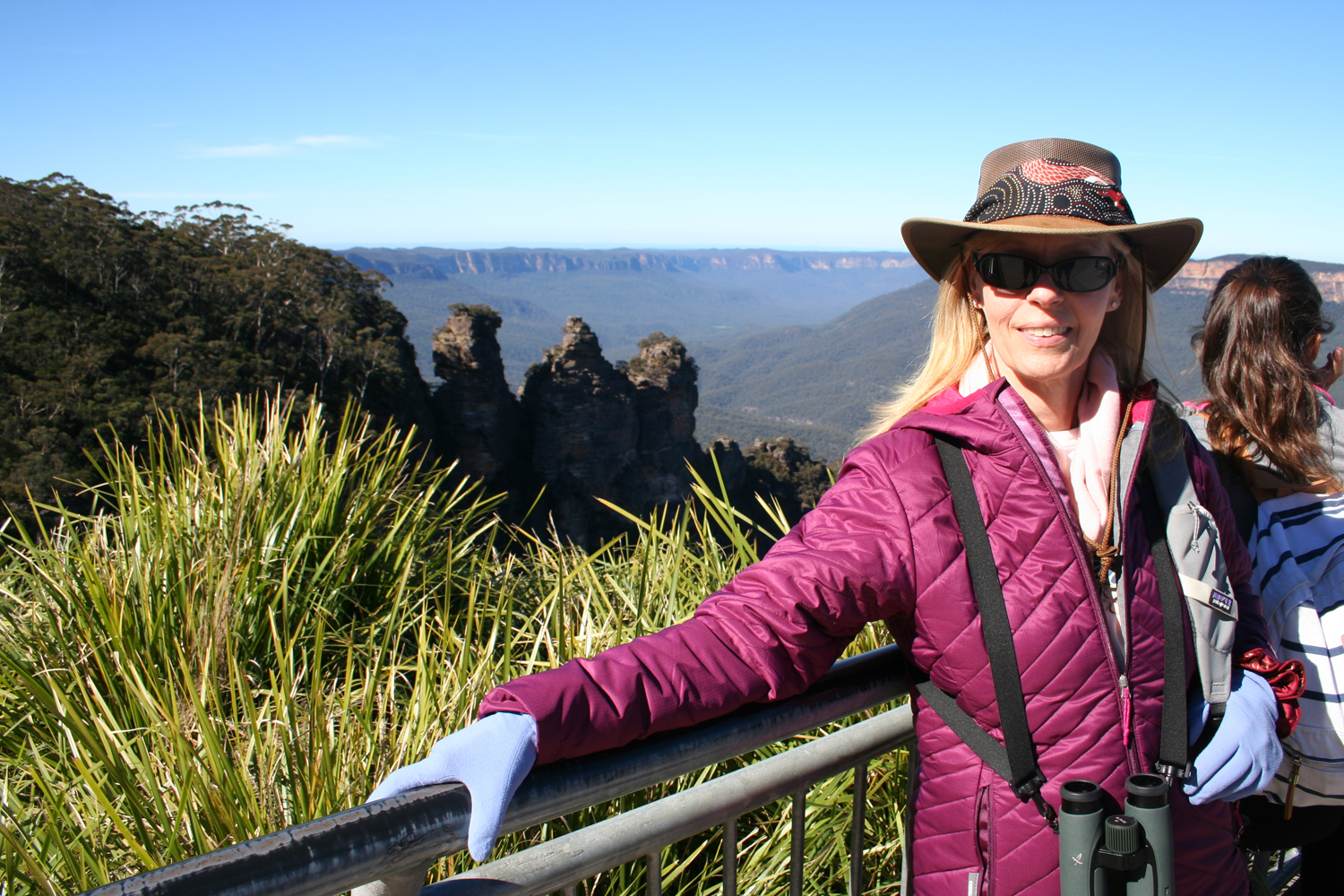
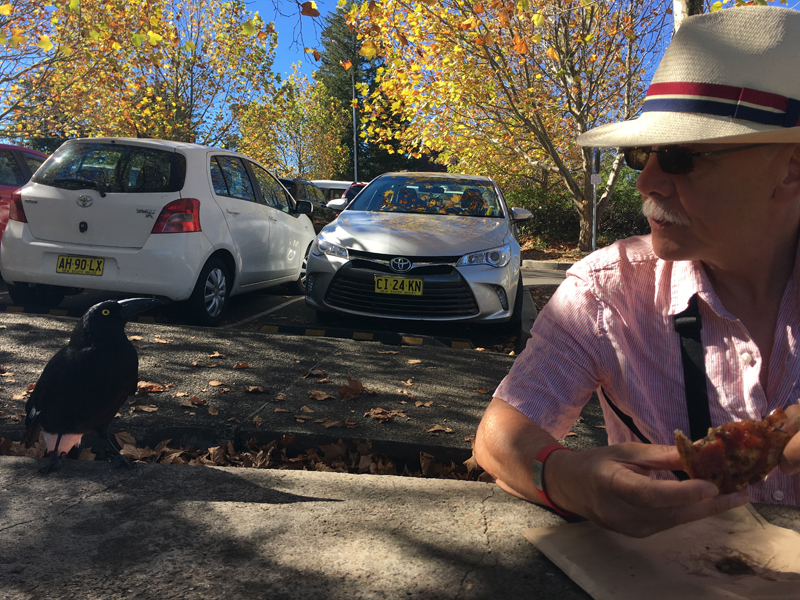
The Three Sisters are one of the Blue Mountains' best known sites, a towering rock formation on the north escarpment of the Jamison Valley. Their names are Meehni (922 m), Wimlah (918 m), and Gunnedoo (906 m). The Sisters were formed by land erosion. The soft sandstone of the Blue Mountains is easily eroded over time by wind, rain and rivers, causing the cliffs surrounding the Jamison Valley to be slowly broken up. The commonly told legend of the Three Sisters is that three sisters, Meehni, Wimlah and Gunnedoo, lived in the Jamison Valley as members of the Katoomba tribe. They fell in love with three men from the neighbouring Nepean tribe, but the marriages were forbidden by tribal law. The brothers were not happy to accept this law and so decided to use force to capture the three sisters. A major tribal battle ensued, and the sisters were turned to stone by an elder to protect them, but he was killed in the fighting and no one else could turn them back. This legend is claimed to be an Indigenous Australian Dreamtime legend, however, Dr Martin Thomas, in his work "The artificial horizon: imagining the Blue Mountains", clearly shows that the "aboriginal" legend is a fabrication created by a non-Aboriginal Katoomba local, Mel Ward, presumably to add interest to a local landmark. The story originated in the late 1920s or early 1930s and is unknown prior to that date.
Back in 2005, the first 75 miles from Parkes towards Sydney were still dirt. At one point we'd even had to get out of the car to manhandle a fallen gum tree back off the road so that we could pass. Now the metalled road ran all the way, and so did the traffic. We passed bill boards with edgy public service announcements. One headline ran: "Report a Tosser" warning of the penalties for littering, and another showed the bare backs of three particularly hirsute men with 30, 50, and 80 (km) speed limit signs shaved on them. "Slow down before things get hairy."
Time was of the essence. Not only did the Parkes Observatory close at 4:15, but we also wanted to get a good head start on the road west before nightfall. We rolled into Parkes-the-town right on cue in the early afternoon, and discovered once again, still, that there was absolutely no signage for the Observatory. We were obliged to stop at an information office to ask for instructions. It was baffling: all their handouts made it transparently clear that this was indeed the major attraction and yet there are no clues on how to find it. We hurried on.
Parkes CSIRO

We found it soon enough, still "standing in a sheep paddock". There was a small garden between the parking lot and the Visitor Center, and with typical Ozzy casualness, a sign beside the (only) path to the entrance warned to "Beware of Snakes". Right-oh.
The Parkes Observatory (also known informally as "The Dish") is a radio telescope observatory, located 20 kilometres north of Parkes. It was one of several radio antennas used to receive live televised images of the Apollo 11 moon landing on 20 July 1969. Its scientific contributions over the decades led the ABC to describe it as "the most successful scientific instrument ever built in Australia" after 50 years of operation.
The Visitor Center was a delight. The selection of toys was excellent, and some were very cool (globes floating in their cradles and slowly, magically. spinning was one waaay too expensive but enticing example). There was a 3D cinema showing three short documentaries. They were supposed to start on a schedule, but the assistant told Claudia she could go right ahead and she'd fire them up if she wanted to see them. After a couple of minutes the assistant struck a deal with me: go in, check it out, if it doesn't make you throw up, stay, otherwise come back out again, no charge. Deal. I watched the whole thing. The cafe next door was every bit the equal, with a delicious home made steak and burgundy pie for me, excellent chips for both of us, some sort of glutten-free pastry for Claudia, and an interesting soda collection (I had pear and ginger or some such).
Of course we spend some time just staring at The Dish itself. and taking a bunch of portraits, but there's not a lot to say about that, other than how special it was to be in its presence again, and this time sharing it with my honey. A special moment. A quick final tour to settle up with the Visitor Center assistant who refused to charge me for my cinema ticket, and then back on the road, through Parkes, and by 4:30 we were offically on the "Road to Adelaide" section of the trip.
Writing this blog forced me to concede that pretty much everything I know about The Dish, and indeed the Apollo 11 moon landing, is from multiple watchings of the wonderful namesake movie. This seems like an appropriate place to see if I can cobble together a more factually-based account. The following rathole is adapted from material I found on the official Parkes CSIRO website. So bear with me. I don't understand all of the technical stuff either, just ignore those words. There's some interesting (even amusing) gems in here, including references to Barnes Wallace and microwave ovens. No, really. I'm pleasantly surprised to discover that the movie actually does a pretty good job at staying on the rails of truth.
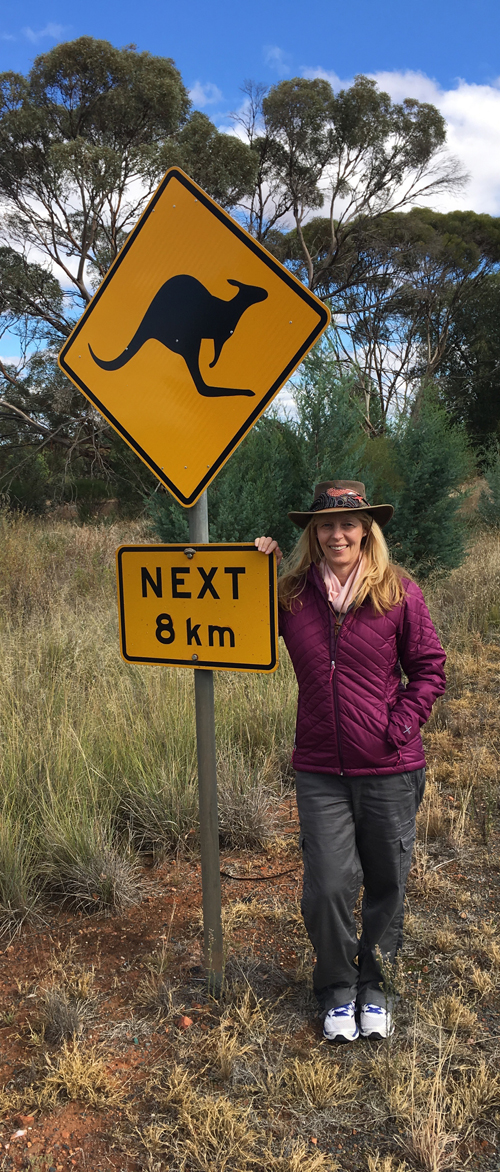
The Radio Telescope in General ...
The primary observing instrument is the 64-metre (210 ft) movable dish telescope, second largest in the southern hemisphere, and one of the first large movable dishes in the world. It is one of the telescopes comprising CSIRO’s Australia Telescope National Facility. An "icon of Australian science", the Parkes radio telescope has been in operation since 1961 and continues to be at the forefront of astronomical discovery thanks to regular upgrades. The Dish operates 24 hours a day, every day of the year. The dish surface was physically upgraded by adding smooth metal plates to the central part to provide focusing capability for centimetre and millimetre length microwaves. The outer part of the dish remains a fine metal mesh, creating its distinctive two-tone appearance.
The telescope has an altazimuth mount. It is guided by a small mock-telescope placed within the structure at the same rotational axes as the dish, but with an equatorial mount. The two are dynamically locked when tracking an astronomical object by a laser guiding system. This primary-secondary approach was designed by Barnes Wallis. The success of the Parkes telescope led NASA to copy the basic design in their Deep Space Network, with matching 64 m dishes built at Goldstone, California, Madrid, Spain, and Tidbinbilla, Australia.
In 1998 the Parkes telescope began detecting fast radio bursts and related signals named perytons. At the time it was theorised that these may have been signals from another galaxy, emissions from neutron stars becoming black holes or interference from lightning strikes. In 2015 it was determined that the perytons were caused by staff members opening the door of the facilities' microwave oven during its cycle. When the microwave oven door was opened, 1.4 GHz microwaves from the magnetron shutdown phase were able to escape. ″Subsequent tests revealed that a peryton can be generated at 1.4 GHz when a microwave oven door is opened prematurely and the telescope is at an appropriate relative angle″. ″It is still not clear if microwave ovens can be blamed for all instances of peryton reception″.
... the Moon Landing in Particular
It was one giant leap for mankind, and it was taken at 12.56 pm Australian Eastern Standard Time (AEST) on Monday 21 July 1969. Six hundred million people, or one fifth of mankind at the time, watched Neil Armstrong's first steps on the Moon. Three tracking stations were receiving the signals simultaneously: CSIRO's Parkes Radio Telescope, the Honeysuckle Creek tracking station outside Canberra, and NASA's Goldstone station in California.
The signals were relayed to Mission Control at Houston. During the first few minutes of the broadcast, NASA alternated between the signals from its two stations at Goldstone and Honeysuckle Creek, searching for the best quality images. When they switched to the Parkes pictures, they were of such superior quality that NASA remained with the Parkes TV pictures for the remainder of the 2½-hour telecast.
But it almost didn't happen. In late 1968 NASA had asked for Parkes to be used in the Apollo 11 mission. The then Director of the Parkes Observatory, John Bolton, insisted on a one-line contract with NASA: "The [CSIRO] Radiophysics Division would agree to support the Apollo 11 mission". The giant telescope would be the prime receiving station for the reception of telemetry and TV from the surface of the Moon. Using it provided extra gain in signal strength from the moon meaning that during the tightly scheduled first moonwalk the astronauts would not have to spend time setting up a large antenna to get the necessary signal strength.
At 6:17 a.m. (AEST) on 21 July, astronauts Neil Armstrong and Edwin (Buzz) Aldrin landed their LM, Eagle, on the Sea of Tranquillity. It was still some seven hours before the Moon would have risen high enough to be seen from Parkes.
The schedule required the astronauts to rest before attempting the moonwalk, by which time the Moon would have been high overhead at Parkes. However, Armstrong departed from the original plan, opting for an immediate moonwalk instead. To the astronomers at Parkes, it looked as though the moonwalk would be all over before the Moon even rose over Parkes. However, it took the astronauts such a long time to don their spacesuits and depressurise the LM cabin that as they left the module the Moon was just rising over Parkes. It seemed as though they would get the signals after all.
But suddenly troubled loomed. While fully tipped over waiting for the Moon to rise, the telescope was struck by a series of severe, 110 km per hour gusts of wind, which made the control room shudder. The telescope was slammed back against its zenith axis gears. This was a dangerous situation, threatening the integrity of the telescope structure. Fortunately, cool heads prevailed, and as the winds abated, Buzz Aldrin activated the TV camera just as the moon rose into the telescope's field of view, and tracking began.
Using a less sensitive 'off-axis' detector, Parkes was able to receive the TV pictures just as the LM TV camera was switched on. Less than nine minutes later the Moon had risen into the field of view of the Parkes telescope's main detector. For those first nine minutes of the broadcast, NASA alternated between the signals being received from its two stations at Goldstone and Honeysuckle Creek, searching for the best quality picture. Because Parkes was a larger telescope, it captured more signal and so produced better pictures. The quality of the TV pictures from Parkes was so superior that once the TV was switched to the Parkes signal, NASA remained with those pictures for the rest of the 2.5 hour broadcast. "The Television Broadcasts" from the report "On Eagles Wings" provides a fascinating description of a debate between Richard Holl and NASA Controller Charlie Goodman at that nine minute mark as to when and why that signal switch should be made. Charlie was responsible for selecting the video from either Honeysuckle Creek or Parkes to send via satellite to Houston. RT: Other than the fact that he was also from NASA, I can't find a reference to Richard (Dick) Holl's actual role, but he's in many of the pictures of the folks in the Paddington (Sydney) OTC (Overseas Telecommunications Commission) Paddington gateway exchange.

Parkes staffer Neil 'Fox' Mason, who was seated at the control desk, drove the telescope without being allowed to once turn around and see the incoming pictures on the TV monitor. It was essential for him to monitor the tracking of the telescope, in case the winds picked up again, threatening the signal reception. The weather remained bad at Parkes, with the telescope operating well outside safety limits for the entire duration of the moonwalk.
The signals were sent to Sydney via specially installed microwave links. From there the TV signal was split. One signal went to the Australian Broadcasting Commission (ABC) studios at Gore Hill for distribution to Australian television networks. The other went to Houston for inclusion in the international telecast. Because the international broadcast signal had to travel halfway around the world from Sydney to Houston via the INTELSAT geostationary communications satellite over the Pacific Ocean, a 300 millisecond delay was introduced to the signal. Australian audiences therefore witnessed the moonwalk, and Armstrong's historic first step, some 0.3 seconds before the rest of the world.
West Wyalong
A little after dark we finally rolled into West Wyalong. One of the first buildings was a tavern, and next door was a motel. Perfect. After settling Claudia in, I walked back to the tavern. It was packed, with at least six or seven tables occupied, and more out in the beer (smoking) garden behind. A couple of men at one end of the bar we engrossed in several screens dedicated to greyhound and harness racing. In another corner a dozen folks of all ages were celebrating some sort of birthday party. I sat at the bar and watched the world. Someone came up to the counter and left two stacked beer glasses with a $20 bill stuffed in the top. I presume he went out to the bathroom because the choreography could not have been timed more perfectly. As the patron returned, the barman turned around to drop the change into his open hand. Without pausing, and without speaking, he picked up his two refreshed glasses and returned to his seat.

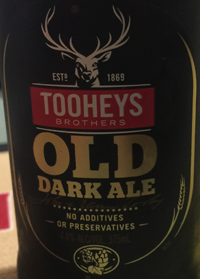
Equally silent, I was half way down my second stubbie of Tooleys Extra Dark when I noticed that the woman sat between the two guys around the corner from me at the bar was wearing a Boston sweatshirt. I asked how she had come by it. "Bought it in Adelaide." Sigh. But having broken the ice, she wanted to know about my note book, which I always carry with me, and which had apparently provided grounds for suspicion. "Not writing anything bad about us?" "Oh no, I always write good things while I'm in the bar. I leave the bad stuff until I am a safe distance away." Now we were finally talking, I broke the rules and ordered a third bottle. I discovered that the reason everyone was giving the barmaid a hard time about her beer-pouring skills (a woman my age or older) was a) because she was normally in the kitchen, and b) because she (Jenny) and her husband (Ralph) owned the tavern. Ralph was sitting on the customer side of the bar drinking with Leoni (of the Boston sweatshirt). Ralph and Jenny filled me in on some of the other characters. Jenny pointed to one younger man in road-crew safety gear. "He's a keeper." She paused. "I wouldn't take him home to my mother, but he's a keeper in the bar." Ralph described someone else as "way passed prime possum" but of course this was not held against her. They loved my love of long blacks (coffees) and meat pies. Jenny was reminded of a song, which she then looked up on YouTube to prove it. "Football, meat pies, kangaroos and Holden cars ..." Thanks to our earlier run-in with the rental car I was now well aquainted with Holden cars. The video was pretty dated, and I was clearly expected to provide some sort of response. Two and a half beers in, I said "Hmm, it does seem to imply you are 'of a certain age'". Thankfully this was met with gleeful approval. The long-distance truck driver who made up the rest of our little group gave me some recommendations for what to expect the following day, and where to stay at the end of it, then it was time for a couple of group photos, and the short walk home to bed.
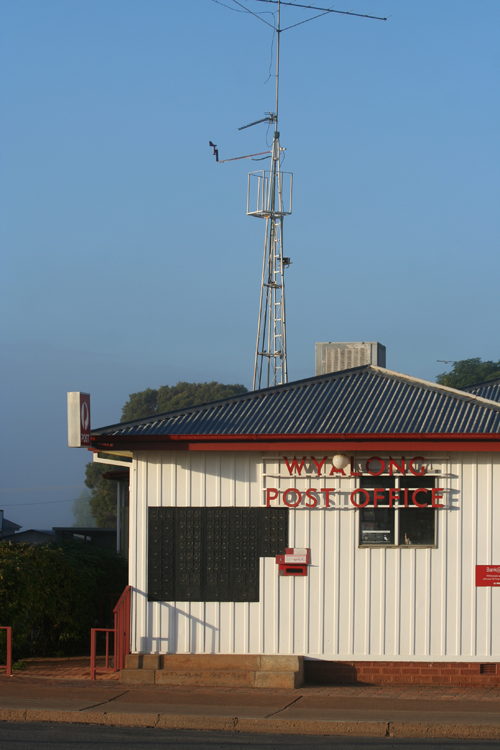 |
 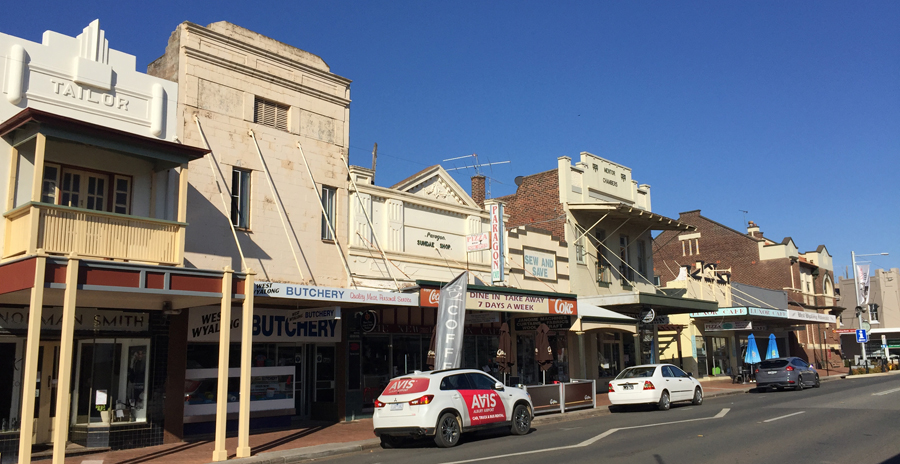 |
Day 2: West Wyalong to Paringa

Once again, corrigated iron was a favorite construction material, and we nearly missed the supermarket because it looked so unassuming, not to say industrial. Inside the signs were also painted onto corrigated sheets. Low key it might have been, but the products for sale were all excellent. We got some of the best gluten-free bread I've ever eaten, and the yoghurt selection was so vast we ended up buying half a dozen just to try the flavors. The dairy section was right at the back of the store, as it often is, but the back of the store was actually a different store: Dave's Five and Dime or something similar. The dairy coolers faced Dave's side. When this arrangement forced us to ask another customer to help us find them, he suggested that "Dave had insisted, to get people into his half of the building." After being warned not to buy more fruit than we could eat in the next few hours because everything else would be confiscated at the fruit fly border, we paid for what was left in our basket and headed out for the final chore, the mandatory gas top up. As another example of a bygone age, when you pump gas, you pump first and then head in to the shop to pay up. There was a chirpy young thing behind the counter. "Another glorious day in paradise" I said as I handed her my card. "In Wallyworld" she snarked as she dealt with the card.
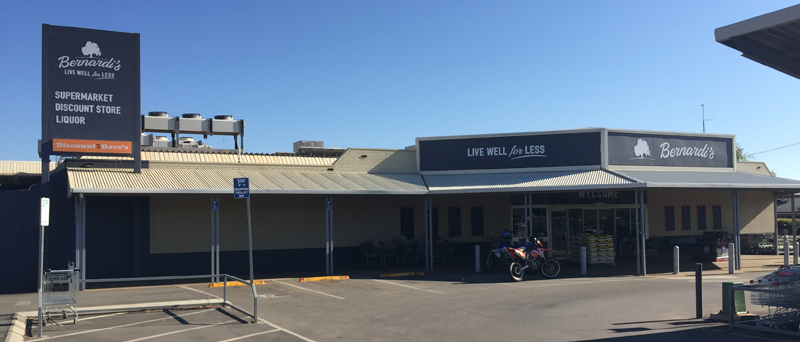 |
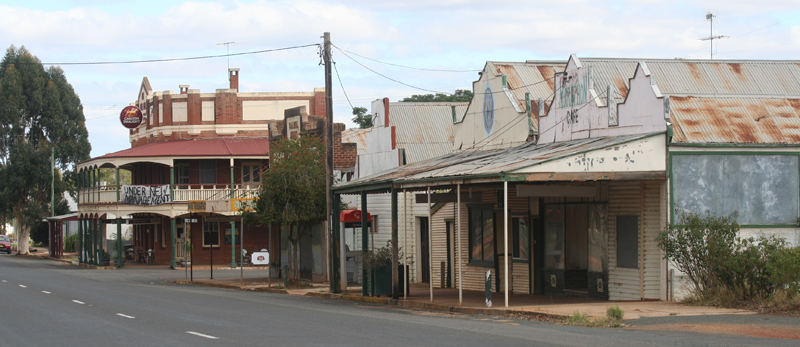 |
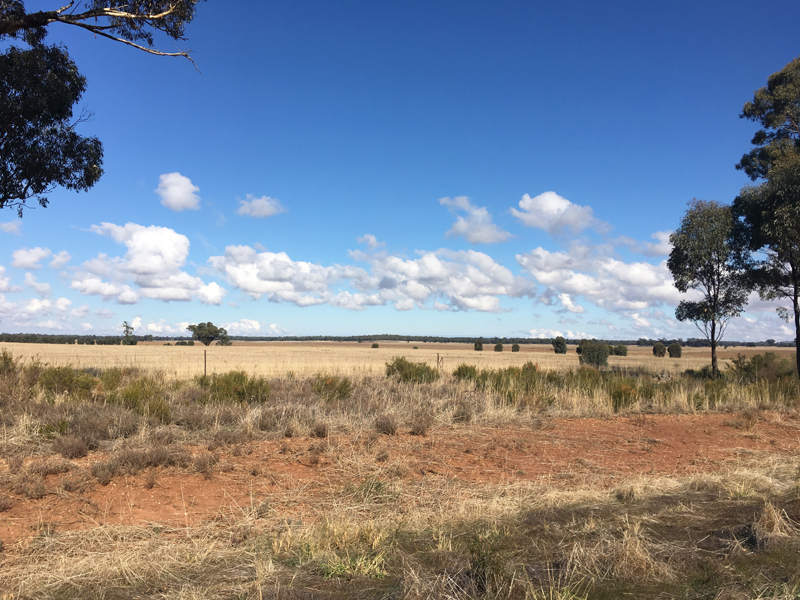 |
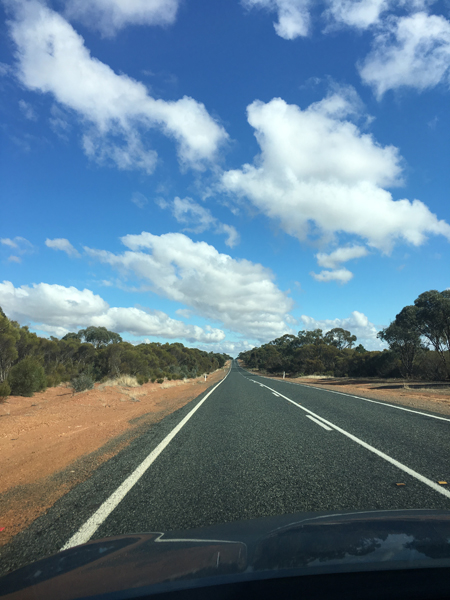 |
Gassed up, we set off but we were still missing a couple of key ingeredients: a long black (coffee) and a meat pie from a local bakery. But the next town had exactly what we needed—at the Roadkill Grill. As we pulled over, a huge crop-spraying tractor pulled up behind us. You could comfortably walk underneath it. I assume it was used for tending to the several miles of cotton fields we had just passed. A young man climbed down the ladder (which since it was still so fresh in my memory, reminded me of Armstrong descending to the moon) and crossed the road with us. Before we reached the door of the cafe, a pre-schooler crashed through it hotly pursued by his mother. "He's tractor crazy" she offered as they rushed by and she caught him before he got to the road. The young farmer turned back and asked "Does he want a ride?" "Really?" "No problem, we'll be right back". Everyone (including me, I wasn't going to miss this) crossed back across the road. We snapped some pictures, and then the pair climbed back into the cab and they were off. Linda-of-the-cafe gave me her credentials in case I got some good snaps "my camera is crap" and then we returned, finally, for my excellent long black and pie.
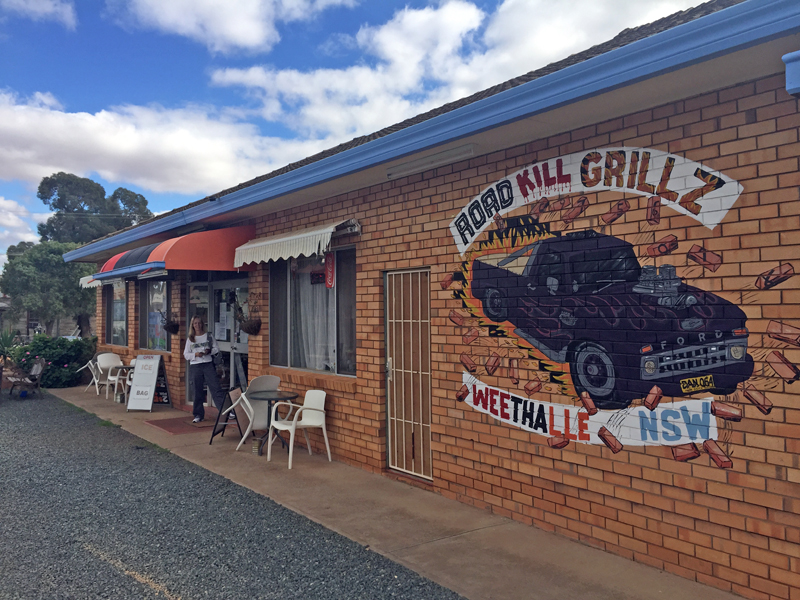 |
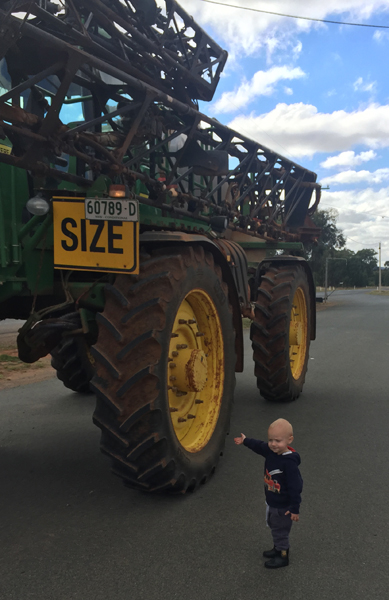 |
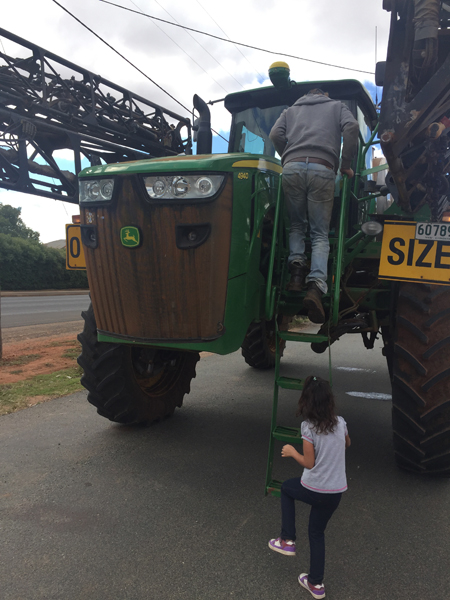
|
Now we could get down to business. With 430 miles between West Wyalong to Renmark, we would have to keep the pressure on to arrive before dark. As clearly as Day 1 was the Blue Hills, to my considerable surprise, Day 2 was back to the outback. As advertized, for 150 miles across the Hay Plains from Goolgowi to Balranald it was nothing but saltbush and the occassional eucalypt stand. This time there was fauna close enough to the road that we could stop and watch. Multiple times we had to do a U-turn to get a better view of something we'd just caught a glimpse of as we blew by.
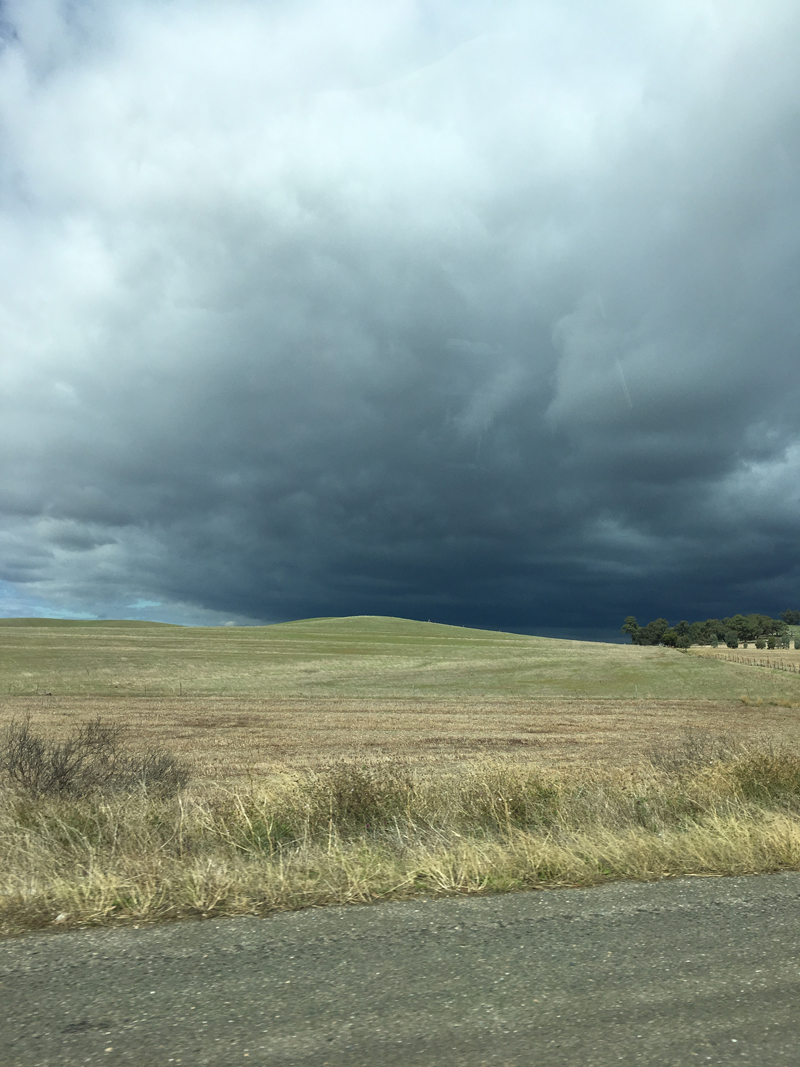 |
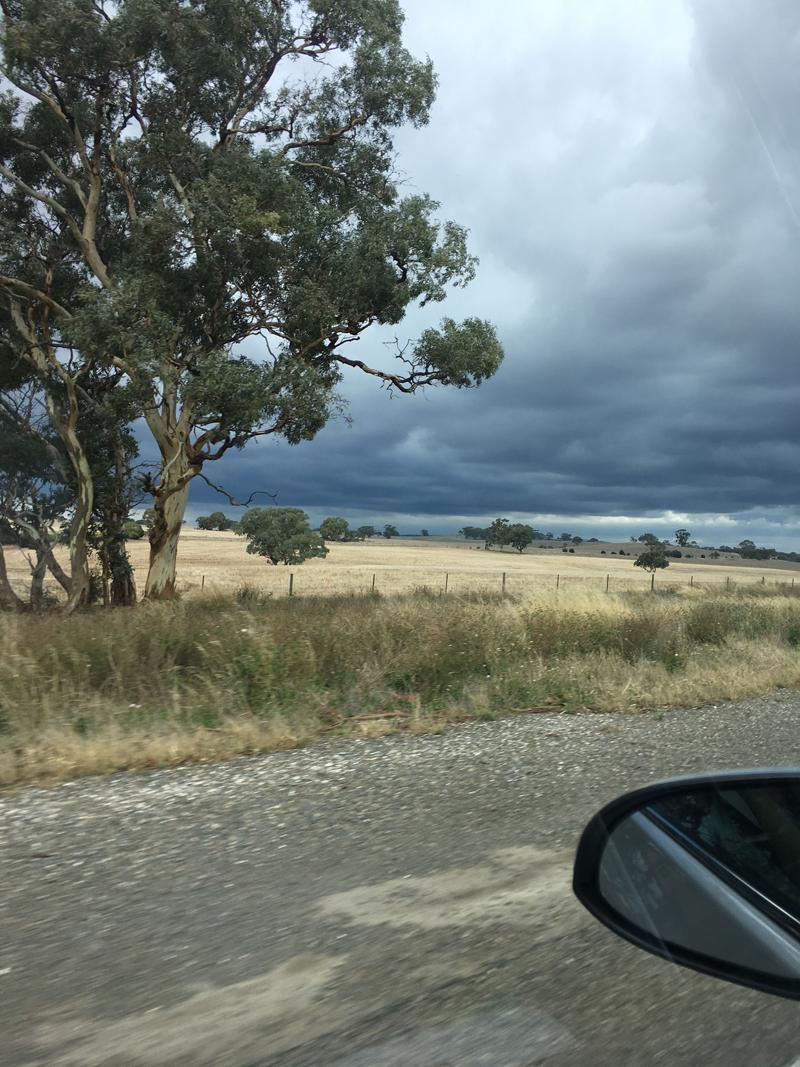 |
After Balranald there was more of not much except our book on tape. We crossed the Darling at Robinvale and again at Mildura but despite my best efforts, there was nowhere reasonable to stop, the bridges were too narrow for foot traffic anyway, and the resulting moving car shots were disappointing despite my low expectations.
Crossing into South Australia and closing on Renmark, we came to the most authoritarian and officious-looking border crossing I've seen in a long time. It looked like something from a banana republic: very low key buildings, and just a single pole across the road, but with uniformed crossing guards who were taking no prisoners. They looked inside the car, and demanded to see in the trunk. They were looking for immigrants. Six-legged, itty-bitty immigrants: fruit flies. To complete the parody a large sign proclaimed: No Fruit No Veg No Fine. Forewarned and forarmed, we'd scarfed our fruit, had bought no veg, and therefore collected no fine.
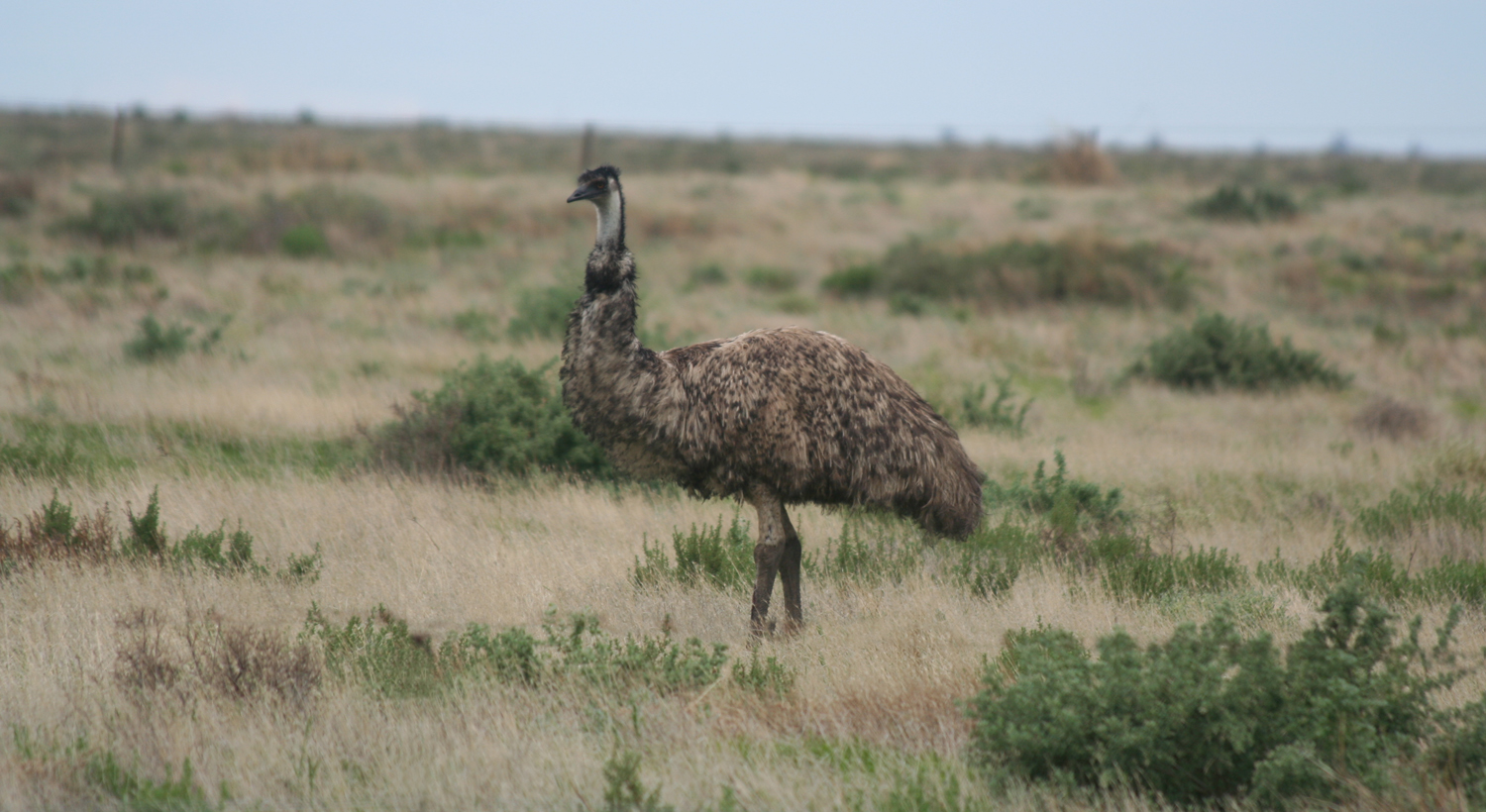
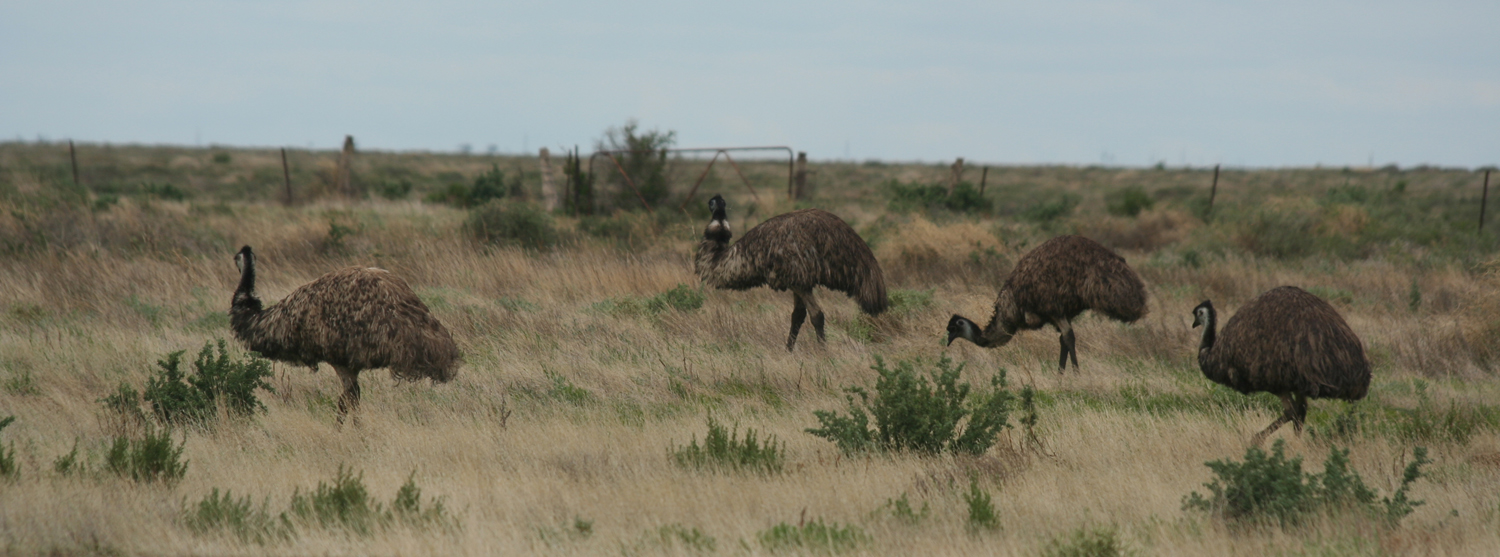


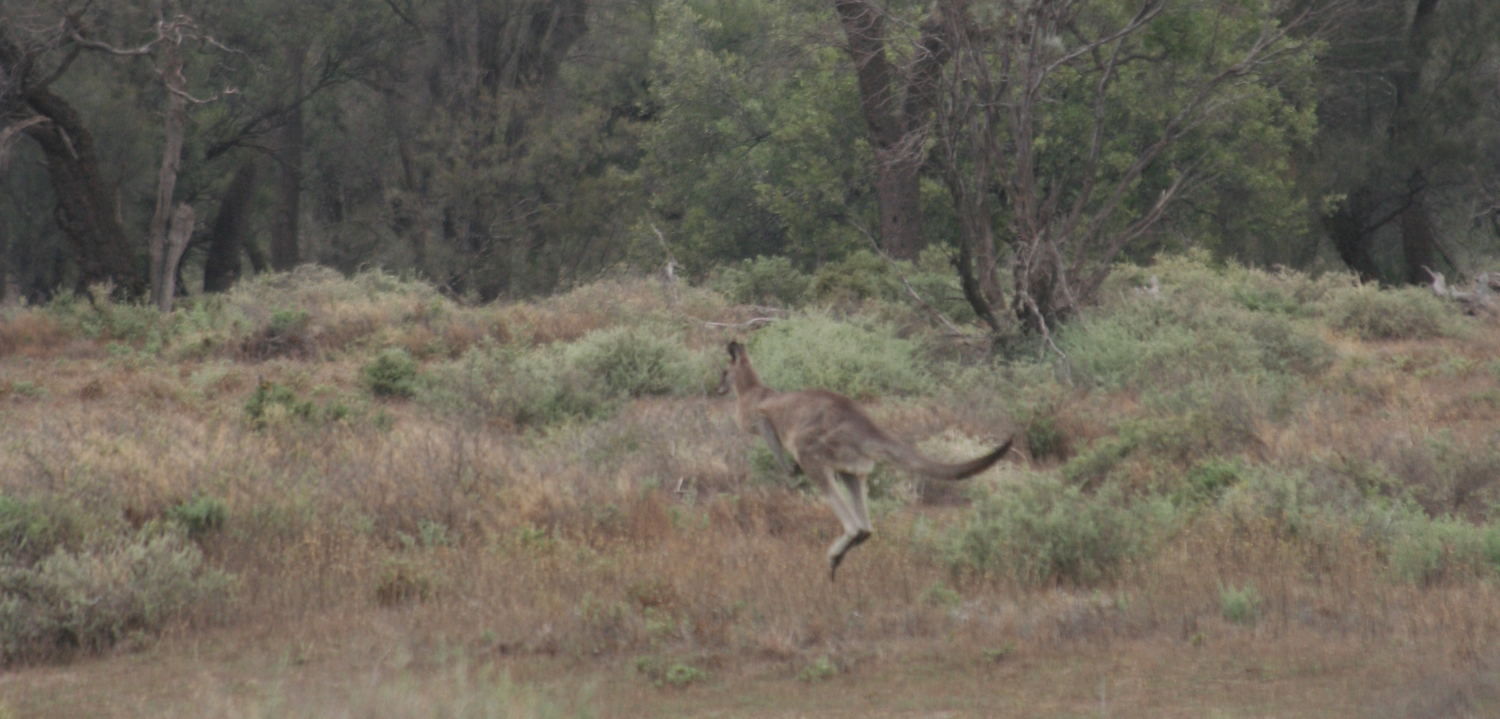
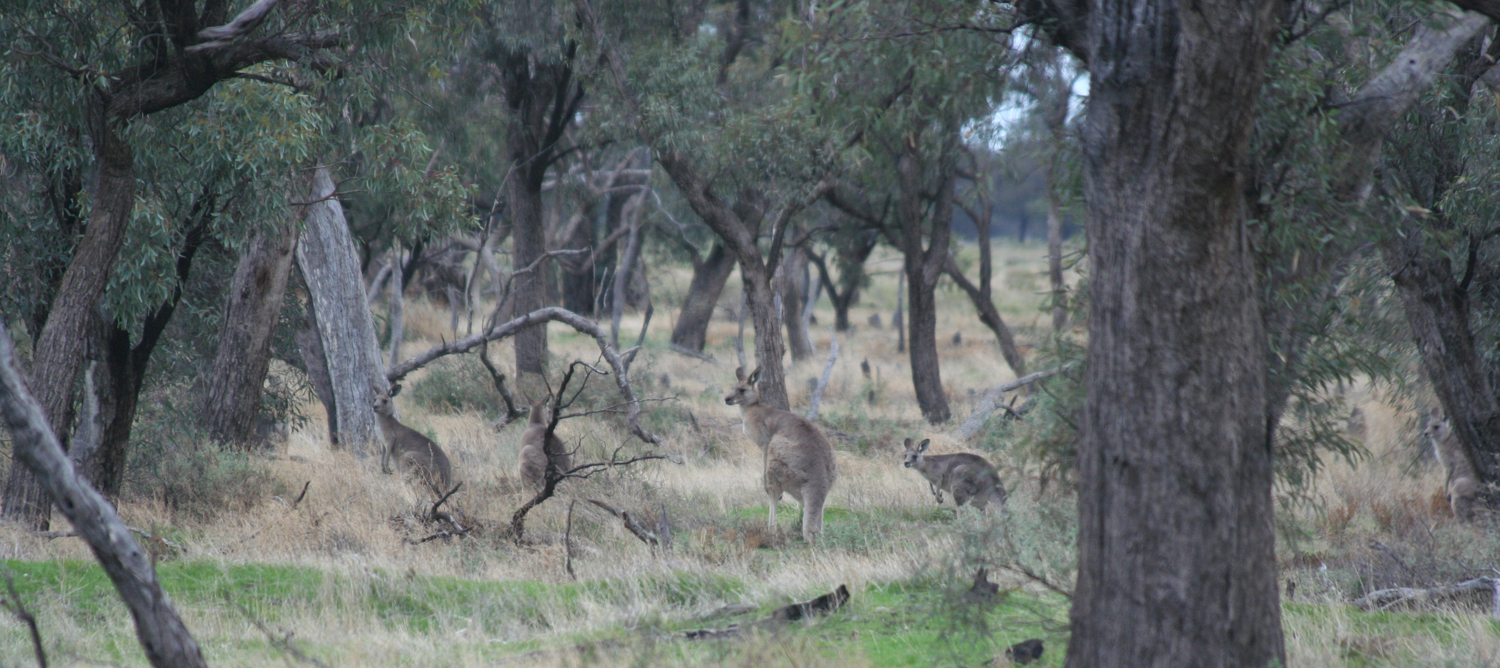
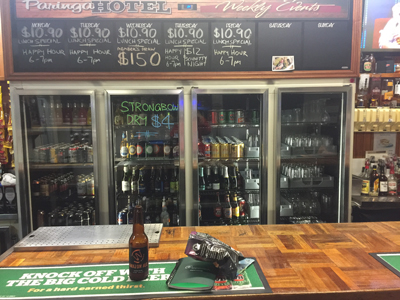
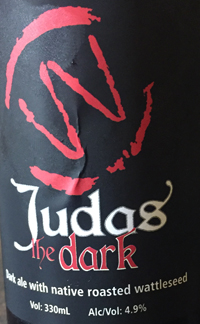
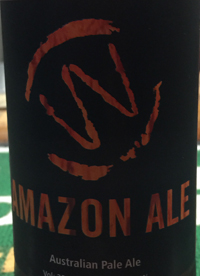
Rolling into Renmark right on cue, we found the Paringa Hotel almost immediately on the right, as described. A classic example of an Aussie hotel designed to hold hundreds, with a full-blown restaurant, the bar (of course) and several completely deserted (to the point of being unlit) game and community rooms, to say nothing of two or three wings of guest rooms behind. It was several minutes walk from our room back to the bar. I walked by the Hotel Curtesy bus, which I imagined was used to deliver over-served patrons back to their homes. At least there were a couple of couples in the restaurant. I checked the menu and the salad bar, but I wasn't hungry enough to eat anything that wasn't a bargain, or some sort of local delicacy, and nothing was even close. The bar itself had just one other patron, who was definitely well-refreshed. The signal-to-noise ratio of useful words vs the f-bomb was so low it was quite difficult to keep track of the actual thread of his conversation with the barman.
It was really a pretty depressing scene. Flourescent lighting of course, but the whole room was just totally devote of any frills that might have provided a hint of warmth or welcome. Just a bar, a few formica tables and chairs, a bunch of coolers and a couple of TVs playing who cares what? On a brighter note the coolers contained some microbrews. The Woolshed Brewery is in Murtho, and as I supped a couple of their wares I looked up Murtho on the interweb: it's a suburb of Renmark. Excellent! Since I hadn't been gone more that half an hour or so, Claudia would still be up, so I bought one more for the room, and headed home.
Day 3: To Adelaide and KI
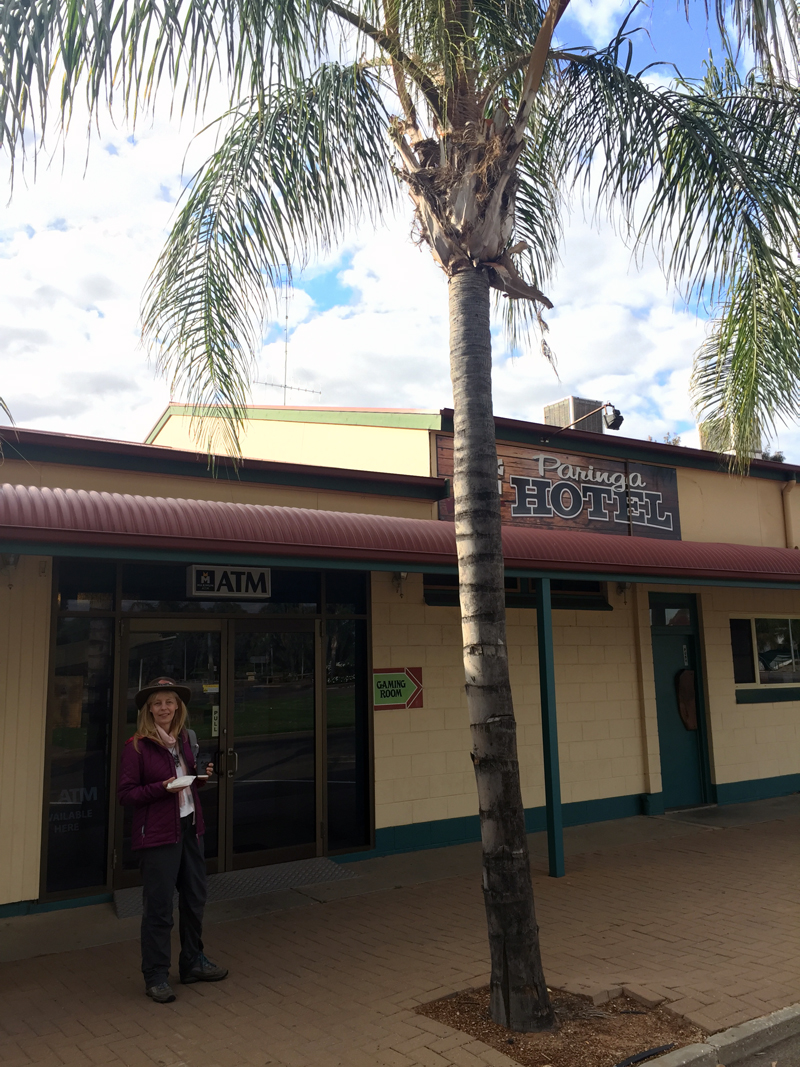
This is where I missed my second hat. My nice straw one. Neither of us could remember where we had last seen it, but a likely spot was surely last night's bar. Of course this morning it was all locked up with no sign of life. The restaurant was not due to open for at least another hour. By the time we discovered this, we had also discovered a bakery at the other end of the little strip mall that was mostly the bar and restaurant. The bakery was open, and lo, had fresh pies! Not just any old pies, but one was steak and kidney, a firm favorite. I showed Claudia the sweet rolls and other favorites from my youth, which like the pies are still common across Australia even though I haven't seen them in the UK for years. By now it was pretty clear that we were foreigners (though I'm kidding myself if that wasn't obvious by the time we'd pushed the door open) so there was something to chat about with the lady at the check out once we'd made our selections. She no compuction about commenting on my pie. "Disgusting. How can you eat that?" "I agree that it is a very distinct flavor, and I can see how it might be everyone's cup of tea, especially if you did not grow up eating it." "Yech. I have to make them and it is the low point of my week. It's as much as I can do not to puke into them." "I'm so glad you manage to avoid that." By now there was another customer, just as clearly local, and he's laughing at us, with us. We talked a little more about why we happen to be here, and the hat story came up. The check out lady immediately picked up the phone. "Let me call Maureen. I'm surprised she wasn't there. She's normally cleaning by now." Two minutes later Maureen, still in her pj's, met me at the pub door, and together we took a tour around the bar, but there was no sign of the hat. Claudia caught up. "We have to try the marron on Kangaroo Island" she says, apparently a final send off from the other customer. I wrote the reference down in my note book, and we were done with Renmark, and with it, out of the fruit-fly free Riverland Region.
There was no time to stop between Renmark and Adelaide, and there was no plan to do so. We passed several things that with days to spare might have occupied us: world-class vineyards for example, but these deserved the time to do them properly. We pressed on into murkier and murkier weather until by the northern outskirts of Adelaide the rain was bucketing down. A perfect moment to gas up. And to finally figure out why we think we are running late, but the GPS thinks we have plenty of time. When we crossed into South Australia, we gained 30 minutes because of one of those you've-got-to-be-kidding-me 30 minute zone shifts. Our disconnected phones didn't know that, but the GPS did. Therefore we arrived with ample time to abandon the car, find the rinky-dink counter for the rinky-dink airline right down at the far end of the terminal, reorganize some of the luggage so that our carry-on was light enough, and hand over the rest of the luggage to be stored. This was a new definition of carry-on: what you couldn't carry on could not fly. The airline hung on to the rest until you returned.